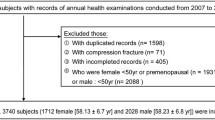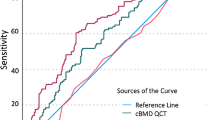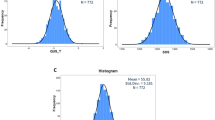Abstract
The objective of this study was to evaluate the diagnostic value of bone density changes in lumbar vertebrae and femoral necks in patients with primary osteoporosis (OP) at various ages. Dual-energy X-ray absorptiometry (DXA) scans were performed on patients who had their primary visits between March 2008 and February 2009. The bone mineral density (BMD) of the lumbar vertebrae 1–4 (L1–L4) in anteroposterior projection and the proximal femoral neck in lateral projection were measured. If the BMD values (T score) of any site is −2.5 or less (T ≤ −2.5), the patients were diagnosed as primary OP, and the T scores were statistically analyzed. The 81 patients who had lumbar vertebrae with a T ≤ −2.5 led to a positive rate of 80.1 % in the diagnosis of primary OP; the 47 patients who had femoral neck with a T ≤ −2.5 gave a positive rate of 47.0 %. The patients with type I or type II primary OP were divided into two age groups of ≤70 and ≥71 years old. The comparison of lumbar spine T score values did not show significant statistical difference (P > 0.05) between the age groups, while the result of the femoral necks revealed significant difference between the two groups (P < 0.001). In diagnosis of primary OP, anteroposterior lumbar spine offers a significantly higher detection rate than that of the femoral neck, but to the patients older than 70, the measurement of femoral neck may generate higher detection rate. It is more sensitive to measure lumbar trabecular bone, especially to the patients in early postmenopausal period. BMD in elderly patients may falsely increase with age, attention should be paid to the determination of the hip bone mass.
Similar content being viewed by others
References
Pientka, L., & Friedrich, C. (2000). Osteoporosis: the epidemiologic and health economics perspective. Z Arztl Fortbild Qualitatssich, 94, 439–444.
Bai, M. H., Ge, B. F., Bai, J., Chen, K. M., Zheng, R., & Yin, Y. (2008). Analysis of bone mineral density in normal people in Lanzhou area. Chin J Osteoporos, 14(10), 736–737.
Lu, J. L., & Lin, S. Q. (2002). The management of postmenopausal osteoporosis. China Contemp Med, 4(8), 63–67.
Huang, Y. X., Hu, Q. L., & An, A. H. (2007). The investigation of bone mineral density of different sites in 268 women with osteoporosis. Chin J Osteoporos, 13(10), 712–715.
Li, E., Xue, Y., Wang, H., & Yang, D. (2005). Differential diagnosis and treatment of osteoporosis (first edition) (p. 139). Beijing: People’s Health Press.
Author information
Authors and Affiliations
Corresponding author
Rights and permissions
About this article
Cite this article
Jiang, E., Wang, Z., Meng, Q. et al. Study on Bone Density at Various Skeletal Sites for the Diagnosis of Primary Osteoporosis. Cell Biochem Biophys 64, 1–3 (2012). https://doi.org/10.1007/s12013-012-9361-2
Published:
Issue Date:
DOI: https://doi.org/10.1007/s12013-012-9361-2




